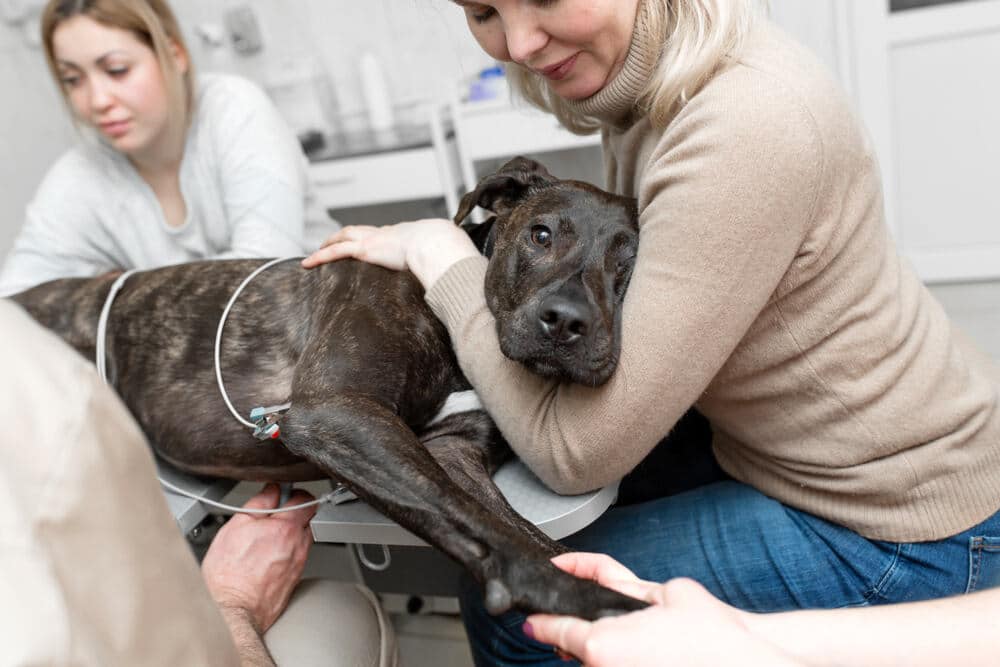Here’s a breakdown of why dogs may refuse to give birth (uterine inertia), focusing on what owners need to know:
What is Uterine Inertia?
- A serious condition where a dog in labor either doesn’t have contractions at all, or contractions stop/weaken before all puppies are born.
- Types:
- Primary: No labor starts, the dog doesn’t even seem to be trying.
- Secondary: Labor started, but the dog gets exhausted and stops.
Why Does it Happen?
- Environment: Stress, unfamiliar surroundings can stall labor.
- Hormone Issues: If the body’s signals to “start pushing” aren’t working right.
- Physical Obstruction: Oversized puppy, one stuck in the wrong position.
- Exhaustion: If labor goes on too long, or the dog is unfit (obese)
- Underlying Health Issues: Low calcium/blood sugar are sometimes linked
Signs of Trouble
- Past Due Date: Know when she’s due, and if past that with no signs of labor, call the vet.
- Green Discharge: Means puppies are starting to pass, labor SHOULD follow soon. If not, get help.
- Long Gaps: 2+ hours between puppies without active pushing is concerning.
- Weak Pushing: Dog seems to be trying, but nothing happening for a long time.
How Vets Help
- Diagnosis: Physical exam, checking blood levels, sometimes even x-rays.
- Medication: Drugs to trigger contractions MAY work, if no physical blockages.
- C-Section: If medication fails, or puppies are clearly distressed, surgery may be needed.
Key Takeaways
- Don’t expect problems, but be ready: Most births are fine, but things CAN go wrong.
- Know your dog’s due date: This helps spot delays in labor.
- Watch closely when labor is expected: This lets you catch problems early.
- Don’t DIY this: A vet is essential if your dog seems unable to give birth on her own.
What Is Uterine Inertia?
Uterine inertia is commonly known as stalled labor and delivery problems. This is a medical condition where a dog does not experience contraction and refuses to give birth. There are two types of abnormal uterine contractions. These are…
Primary Uterine Inertia:
In Primary Uterine Inertia the dog does not feel the labor pain or the dog does not experience contractions. Hence the dog is unable or refuses to give birth. In this situation, the puppies might die or sometimes it can lead the mother to death. Placental fluid is the only way to confirm the dog is having labor. If we see a dark green fluid then we should contact a vet to encourage the dog to give birth.
Secondary Uterine Inertia:
Secondary Uterine Inertia is a situation where the dog experiences a strong contraction that decreases the strength of the mother to give birth. In this situation, the mother dog gets tired and refuses to give birth. If this situation occurs then we should take the dog vet. Because in this situation only the vet can help the dog to give birth.
Causes Of Stalled Labor and Delivery Problem:
Generally, dogs do not face many problems giving birth. But there are few cases where dogs face a delivery problem or refuse to give birth. There is some reason that causes stalled labor and delivery problems in dogs. So, see below the reason why the dog is refusing to give birth.
Environment:
One of the reasons dogs face stalled labor and delivery problems is the environment. Where the dog lives sometimes is not the suitable environment that encourages the dog to give birth and the dog does not experience any contractions. This is one of the reasons that causes stalled labor and delivery problems.
Uterine Muscles Do Not Respond To Hormonal Signal:
The main reason for stalled labor and delivery problems is the dog does not experience any contractions. This happens when the dog’s uterine muscles do not respond to hormonal signals that lead the dog to refuse to give birth.
Hormonal Imbalance:
Another reason the dog faces stalled labor and delivery problems is hormonal disorder. If a dog is facing stalled labor and delivery problems then it is possible the dog does not experience contraction and can not give birth.
Oversized Puppies:
Another reason for stalled labor and delivery problems is the puppies are oversized. When the puppies are oversized the dog gets tired of pushing and eventually loses all its strength and refuses to give birth.
Obesity:
Obesity is another reason that a dog is facing stalled labor and delivery problems as puppies get stuck and can not come out.
Faulty Position:
Sometimes the puppies are in a faulty position in the reproductive tract and the dog can not give birth no matter how she pushes and eventually gets tired and refuses to give birth.
How To Diagnose Stalled Labor and Delivery Problems In Dogs?
The Diagnosis of stalled labor and delivery problems is very important. If we see she is not giving birth by her due date or does not give any sign of labor then we should take the dog to the vet.
In stalled labor and delivery problems the dog does not experience the labor, so we should monitor the dog closely closer to her due date.
A physical examination can diagnose stalled labor and delivery problems in dogs. If the dog has low levels of blood glucose and calcium then the dog can face stalled labor and delivery problems. So, we need to give our pregnant dog a nutrient-rich food.
How To Treat Stalled Labor and Delivery Problems In Dogs?
There are some drugs that help to treat stalled labor and delivery problems. After a physical examination of the dog, the vet will prescribe the drug. These drugs promote uterine muscle contractions. This medicine is given to the dog on the preliminary diagnosis. If the dog is not showing any improvement then the vet will give the drug repeatedly.
When our dog is pregnant we should check the dog’s calcium and glucose levels. A normal calcium and glucose level is required for contractions of a dog. If we see that the dog has a lower level of calcium and glucose then we should consult to vet to normalize the calcium and glucose levels of the dog.
If all the methods do not work then take your dog to the vet. The vet will help the dog to give birth.
Conclusion:
Hope this article is helpful for you. To get healthy puppies and avoid any other sad situation monitor your dog close to its due date. Look if your dog is displaying any sign of labor and consult a vet. If you see any kind of situation of stalled labour then seek a vet’s help. A vet will help you in this situation.
FAQ:
Q. When to seek a vet’s help?
A. Always keep in touch with a vet when the dog is close to its due date. If you feel your dog is refusing to give birth then seek the vet’s help. If you see a delay of two hours between puppies then wait no longer and rush to the vet.
Q. How long is a dog in labor?
A. A dog is in labor for 3-12 hours. Usually, dogs give birth within 6 hours. The maximum time it takes is 24 hours to give birth to all pups. While the dog is in labor keep monitoring the dog and keep in touch with a vet so that you can be prepared if any problem occurs.








